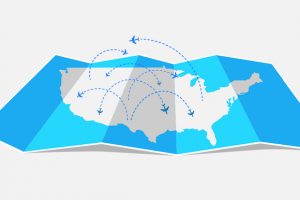The favored model of the American airline industry since its deregulation in 1978, airport hubs have formed the backbone of the country’s present-day aviation network and marketplace. Nowadays these hub-and-spoke systems have become ubiquitous in the U.S. travel sphere, replacing most previous point-to-point models offered by airlines.
By providing greater efficiency and profitability, the hub system seems here to stay, so lets took a look at how this transportation model can benefit both the airline and the passengers they carry.
Why Hubs Matter for Passengers
In a perfect world, every flight would be nonstop, and you'd be jetting off to your destination without any extended connection times or roundabout routings. But in that perfect world, your airfare would likely cost triple.
So why do hubs matter for passengers? The almighty dollar. If airlines can reduce costs by running an efficient hub-and-spoke system, they can, in theory, pass along the savings to the customer. While airport connections aren’t always ideal, hubs allow for carriers to provide more extensive route networks, streamlined operations, and lower fares.
And those low fares come in several forms.
Some of the best-unadvertised savings in the entire aviation marketplace come in the form of hub attacks by competing airlines. These fare wars often instigated by rival carriers trying to undercut prices on select routes from a competitor hub airport, sometimes to the tune of hundreds of dollars.
As an example, Delta might try to drum up sales in a market such as Houston (IAH) that are traditionally dominated by United Airlines by listing fares to destinations in say, Europe or Hawaii, for half the going price. By instigating a fare war, Delta can cut into United’s hub profits and sway customers who are generally handcuffed to United’s monopolized airfares to try their product instead.
These so-called fare wars often escalate quickly with multiple airlines getting in on the action targeting rivals’ hometown hubs across the country. By knowing which hub is nearest to you and which airlines tend to undercut prices when a fare war kicks up might be key in grabbing a rock-bottom fare during one of these short-lived unadvertised sales and save big.
Why Hubs Matter for Airlines
Consolidated route networks play a big part in how airlines can shed overhead on their overall operational costs. Hubs allow airlines to funnel feeder flights with lower passenger volumes through strategically placed airports without having to allot larger aircraft on less popular city-to-city pairings. Thus, adjusting for the total number of travelers on routes and reducing empty seats – the bane of every carrier’s bottom line.
For example, instead of offering a nonstop point-to-point option between two smaller cities like Des Moines (DSM) and Dayton (DAY) that would more than likely fly half empty, these two markets connect through a midway hub like Detroit (DTW) or Chicago (ORD). This allows the airline to better utilize its aircraft and corral passengers between the two points at a profitable schedule while reducing its risk of low passenger loads.
Hubs also provide airlines with a centralized work base for employees, allow for more timely mechanical fixes, and provide additional options for aircraft swaps or adjustments, all of which significantly reduce operating costs compared to a point-to-point system.
A List of Airport Hubs Across America
The following is a list of major U.S.-based carriers and the location of their airport hubs cities.
(Red dots indicate hubs – Yellow for focus cities)
Alaska Airlines
Focused on West Coast markets, Alaska Airlines operates five hubs with its primary hub and headquarters located at Seattle–Tacoma International Airport (SEA). Focus cities of San Diego (SAN) and San Jose (SJC) round out the carrier’s prodigious Pacific Coast presence.
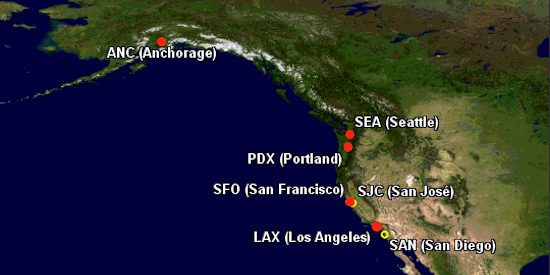
Hubs
- Seattle/Tacoma (SEA) – Primary Hub
- Anchorage (ANC)
- Los Angeles (LAX)
- Portland (PDX)
- San Francisco (SFO)
Focus Cities
- San Diego (SAN)
- San Jose (SJC)
American Airlines
As the world's largest airline, American routes its nearly 200,000,000+ annual passengers through its ten major U.S. hubs. Following its merger with US Airways in 2013, American added Phoenix (PHX), Philadelphia (PHL), Washington DC (DCA), and Charlotte (CLT) to its roster of hub airports. While unofficial, Dallas/Fort Worth (DFW) is considered the airline’s primary hub and home to the company’s global headquarters.
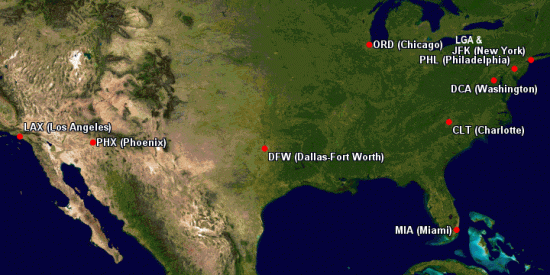
Hubs
- Dallas/Fort Worth (DFW) – Primary Hub
- Charlotte (CLT)
- Chicago–O’Hare (ORD)
- Los Angeles (LAX)
- Miami (MIA)
- New York–Kennedy (JFK)
- New York–LaGuardia (LGA)
- Philadelphia (PHL)
- Phoenix (PHX)
- Washington DC–National (DCA)
Related: American Airlines 777-300ER Business Class Review
Delta Air Lines
Considered to be the first mega-hub in America, Atlanta’s Hartsfield–Jackson International Airport (ATL) is also the world’s busiest and the primary hub for hometown Delta Air Lines. After finalizing its merger with Northwest Airlines in 2010, Delta inherited hubs at Minneapolis (MSP) and Detroit (DTW) and upgraded its presence in Boston (SEA) in 2019 bringing its total hub count to nine.
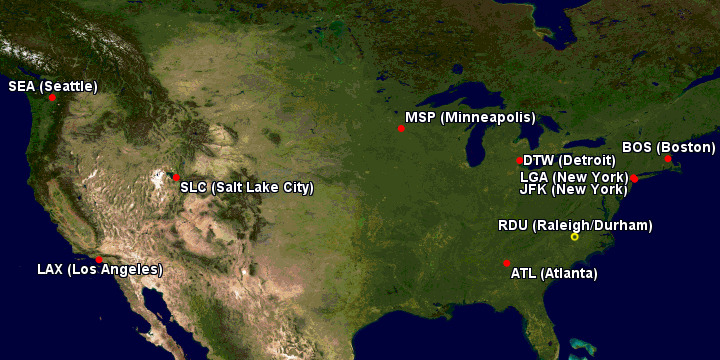
Hubs
- Atlanta (ATL) - Primary Hub
- Boston (BOS)
- Detroit (DTW)
- Los Angeles (LAX)
- Minneapolis/Saint Paul (MSP)
- New York–Kennedy (JFK)
- New York–LaGuardia (LGA)
- Salt Lake City (SLC)
- Seattle/Tacoma (SEA)
Focus Cities
- Raleigh/Durham (RDU)
United Airlines
Chicago-based United Airlines operates a total of seven hubs in the States, including its prime base at hometown O'Hare (ORD) airport. Its merger with Continental Airlines in 2010 has resulted in the addition of Newark (EWR) and Houston-Intercontinental (IAH) to its roster of hub airports. Cleveland Hopkins International (CLE) a former Continental hub has been disbanded by United in favor of increased service at other regional airports.
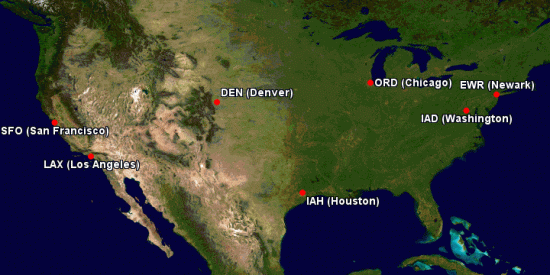
Hubs
- Chicago–O’Hare (ORD) - Primary Hub
- Denver (DEN)
- Houston–Intercontinental (IAH)
- Los Angeles (LAX)
- Newark (EWR)
- San Francisco (SFO)
- Washington DC–Dulles (IAD)
Hawaiian Airlines
Honolulu-based Hawaiian Airlines operates two hubs in the 50th state – its headquarters at Daniel K. Inouye/Honolulu International Airport (HNL) and its secondary outpost on the island of Maui at Kahului Airport (OGG). Kona International Airport (KOA) and Lihue Airport (LIH) serve as focus cities for the airline.
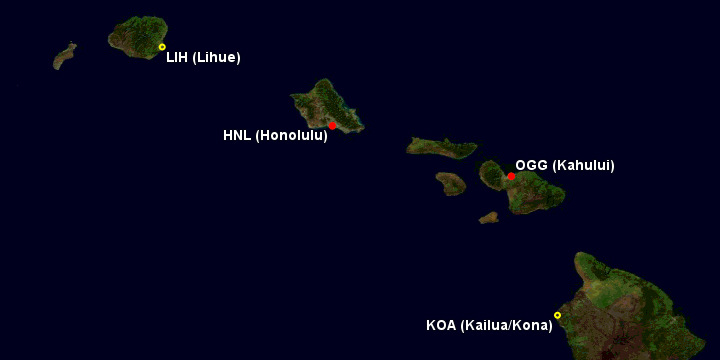
Hubs
- Honolulu–Oahu (HNL) - Primary Hub
- Kahului–Maui (OGG)
Focus Cities
- Kona–Big Island (KOA)
- Lihue–Kauai (LIH)
Frontier
Frontier Airlines forgoes maintaining multiple hubs across its network and relies on a patchwork of focus cities to connect its low-cost customers to their destinations. The budget carrier supports a solitary hub at Denver International Airport (DEN) of which most of its West Coast connections route through. On East Coast operations, Frontier tends to lean toward a point-to-point model but often routes passengers through one of its nine focus airports.
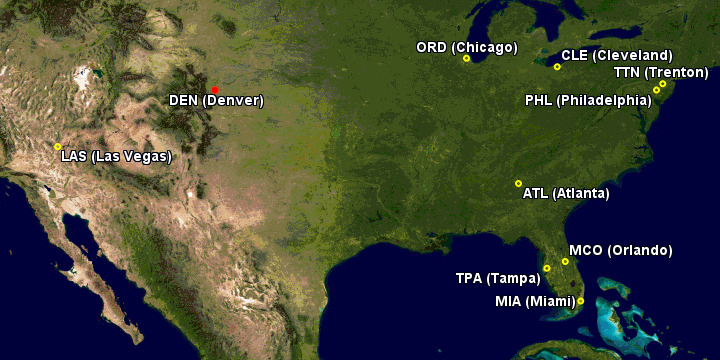
Hubs
- Denver (DEN) – Operating Base
Focus Cities
- Atlanta (ATL)
- Chicago–O’Hare (ORD)
- Cleveland (CLE)
- Las Vegas (LAS)
- Miami (MIA)
- Orlando (MCO)
- Tampa (TPA)
- Philadelphia (PHL)
- Trenton (TTN)
Related: Is Frontier’s New High Cost Airport Fee a Scam?
Sun Country Airlines
Ultra low-cost carrier Sun Country’s route network is primarily connected through its sole hub at Minneapolis-Saint Paul International Airport (MSP). Over the last several years the airline has rapidly expanded its route network outside the confines of its Minnesota hub by adding focus airports at Dallas-Fort Worth (DFW) and Las Vegas (LAS).
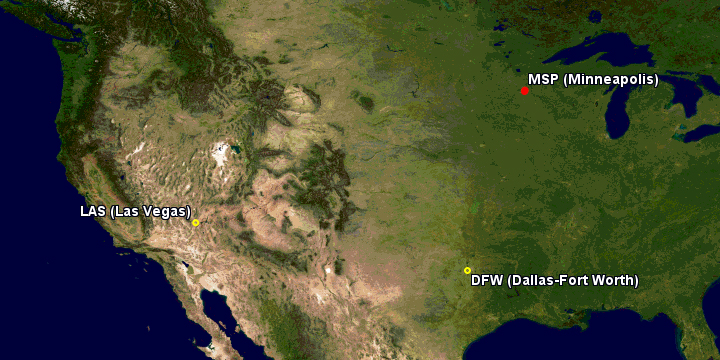
Hubs
- Minneapolis/Saint Paul (MSP) – Primary Hub
Focus Cities
- Dallas/Fort Worth (DFW)
- Las Vegas (LAS)
Airlines With Operating Bases and Focus Cities Instead of Hubs
Not all airlines rely on the hub-and-spoke system; many provide point-to-point networks to route passengers on strategically chosen flight paths to compete with legacy carriers.
JetBlue
New York-based JetBlue prefers to maintain a single operating base at New York's John F. Kennedy Airport (JFK) instead of proclaiming a primary hub. The airline's low-cost model is heavily reliant on nonstop point-to-point offerings rather than funneling its passenger through the more common hub system. With focus airports in five other cities like Boston (BOS), Orlando (MCO), Ft. Lauderdale (FLL), Long Beach (LGB), and San Juan (SJU), JetBlue’s network leans heavy on East Coast air traffic.

- New York-Kennedy (JFK) – Operating Base
- Boston (BOS)
- Fort Lauderdale (FLL)
- Long Beach (LGB)
- Orlando (MCO)
- San Juan (SJU)
Southwest Airlines
The anti-establishment answer to the hub-and-spoke system, Southwest has made its mark as the top airline to favor a point-to-point delivery for its passengers. As the largest domestic carrier in the United States, Southwest prefers to assign its important airports as operating bases. The airline currently lists 11 airports as operating bases. Southwest's recent expansion to Hawaii has given the carrier a strong presence at Honolulu International Airport (HNL), but the airline has yet to designate it a focus city or operating base.

(Only airports designated as operating bases shown)
- Atlanta (ATL)
- Baltimore (BWI)
- Chicago–Midway (MDW)
- Dallas–Love Field (DAL)
- Denver (DEN)
- Houston–Hobby (HOU)
- Las Vegas (LAS)
- Los Angles (LAX)
- Oakland (OAK)
- Orlando (MCO)
- Phoenix (PHX)
Spirit Airlines
Ultra-low-cost carrier Spirit Airlines skips doling out the term hub to its busiest airports in favor of labeling them operating bases. The no-frills airline connects some itineraries through one of its seven nationwide stations but for the most part, relies on single leg city-to-city service to deliver passengers to their destinations.
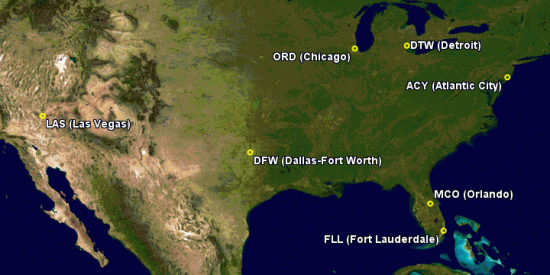
- Atlantic City (ACY)
- Chicago–O’Hare (ORD)
- Dallas/Fort Worth (DFW)
- Detroit (DTW)
- Fort Lauderdale (FLL)
- Las Vegas (LAS)
- Orlando (MCO)
